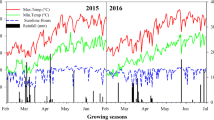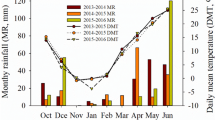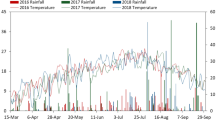Abstract
Nitrogen fertilizer availability to plants is strongly linked with water availability. Excessive or insufficient use of nitrogen can cause reduction in grain yield of wheat and environmental issues. The per capita per annum water availability in Pakistan has reduced to less than 1000 m3 and is expected to reach 800 m3 during 2025. Irrigating crops with 3 or more than 3 in. of depth without measuring volume of water is not a feasible option anymore. Water productivity and economic return of grain yield can be improved by efficient management of water and nitrogen fertilizer. A study was conducted at post-graduate agricultural research station, University of Agriculture Faisalabad, during 2012–2013 and 2013–2014 to optimize volume of water per irrigation and nitrogen application. Split plot design with three replications was used to conduct experiment; four irrigation levels (I300 = 300 mm, I240 = 240 mm, I180 = 180 mm, I120 = 120 mm for whole growing season at critical growth stages) and four nitrogen levels (N60 = 60 kg ha−1, N120 = 120 kg ha−1, N180 = 180 kg ha−1, and N240 = 240 kg ha−1) were randomized as main and sub-plot factors, respectively. The recorded data on grain yield was used to develop empirical regression models. The results based on quadratic equations and economic analysis showed 164, 162, 158, and 107 kg ha−1 nitrogen as economic optimum with I300, I240, I180, and I120 mm water, respectively, during 2012–2013. During 2013–2014, quadratic equations and economic analysis showed 165, 162, 161, and 117 kg ha−1 nitrogen as economic optimum with I300, I240, I180, and I120 mm water, respectively. The optimum irrigation level was obtained by fitting economic optimum nitrogen as function of total water. Equations predicted 253 mm as optimum irrigation water for whole growing season during 2012–2013 and 256 mm water as optimum for 2013–2014. The results also revealed that reducing irrigation from I300 to I240 mm during 2012–2013 and 2013–2014 did not reduce crop yield significantly (P < 0.01). The excessive nitrogen application ranged from 31.2 to 55.4% at N180 and N240 kg ha−1 for different levels of irrigation. It is concluded from study that irrigation and nitrogen relationship can be used for efficient management of irrigation and nitrogen and to reduce nitrogen losses. The empirical equations developed in this study can help farmers of semi-arid environment to calculate optimum level of irrigation and nitrogen for maximum economic return from wheat.






Similar content being viewed by others
References
Akram M (2011) Growth and yield components of wheat under water. Bangladesh J Agric Res 36:455–468
Ali MH, Talukder MSU (2008) Increasing water productivity in crop production—a synthesis. Agric Water Manag 95:1201–1213. doi:10.1016/j.agwat.2008.06.008
Ali MH, Hoque MR, Hassan AA, Khair A (2007) Effects of deficit irrigation on yield, water productivity, and economic returns of wheat. Agric Water Manag 92:151–161. doi:10.1016/j.agwat.2007.05.010
Austin RB, Ford MA, Edrich JA, Blackwell RD (1977) The nitrogen economy of winter wheat. J Agric Sci 88:159–167
Bashir MU, Wajid SA, Ahmad A, Iqbal M (2016) Potential soil moisture deficit: an alternative approach for irrigation scheduling in wheat. Int J Agric Biol 18:16–22. doi:10.17957/IJAB/15.0046
Bremner JM (1960) Determination of nitrogen in soil by the Kjeldahl method. J Agric Sci 55:11–33
Bundy LG, Andraski TW (2004) Diagnostic tests for site-specific nitrogen recommendations for winter wheat. Agron J 96:608–614. doi:10.2134/agronj2004.0608
Chaves AMM, Pereira JS, Maroco J et al (2002) How plants cope with water stress in the field. Photosynthesis and growth. Ann Bot 89:907–916. doi:10.1093/aob/mcfl05
Derby NE, Steele DD, Terpstra J et al (2005) Interactions of nitrogen, weather, soil, and irrigation on corn yield. Agron J 97:1342–1351. doi:10.2134/agronj2005.0051
Ercoli L, Lulli L, Mariotti M et al (2008) Post-anthesis dry matter and nitrogen dynamics in durum wheat as affected by nitrogen supply and soil water availability. Eur J Agron 28:138–147. doi:10.1016/j.eja.2007.06.002
Falkenmark M (1989) The massive water scarcity now threatening Africa: why isn’t it being addressed? Ambio 18:112–118
Fang Q, Ma L, Yu Q et al (2010) Irrigation strategies to improve the water use efficiency of wheat-maize double cropping systems in North China Plain. Agric Water Manag 97:1165–1174. doi:10.1016/j.agwat.2009.02.012
Feng ZZ, Wang XK, Feng ZW (2005) Soil N and salinity leaching after the autumn irrigation and its impact on groundwater in Hetao Irrigation District, China. Agric Water Manag 71:131–143. doi:10.1016/j.agwat.2004.07.001
Fischer RA, Kohn GD (1966) The relationship of grain yield to vegetative growth and post-flowering leaf area in the wheat crop under conditions of limited soil moisture. Aust J Agric Res 17:281–295
Franzluebbers AJ (2002) Water infiltration and soil structure related to organic matter and its stratification with depth. Soil Tillage Res 66:197–205. doi:10.1016/S0167-1987(02)00027-2
Hammad HM, Abbas F, Ahmad A et al (2016) The effect of nutrients shortage on plant’s efficiency to capture solar radiations under semi-arid environments. Environ Sci Pollut Res:1–9. doi:10.1007/s11356-016-7206-z
Hatfield JL, Sauer TJ, Prueger JH (2001) Managing soils to achieve greater water use efficiency: a review. Agron J 93:271–280
Heidarian SA, Akbari GA, Mahfouzi S, Bayat V (2014) Evaluation of the accumulation of assimilates and remobilization in wheat (Triticum aestivum L.) genotypes under limited irrigation conditions. Int J Agric Crop Sci 7:1359–1363
van Herwaarden AF, Farquhar GD, Angus JF et al (1998) “Haying-off”, the negative grain yield response of dryland wheat to nitrogen fertiliser I. Biomass, grain yield, and water use. Aust J Agric Res 49:1067–1081. doi:10.17700/jai.2015.6.1
Homer CD, Pratt PF (1961) Methods of analysis for soils, plants and waters. Div Agric Sci:1–76
Hussain MI, Shah S, Hussain S, Iqbal K (2002) Growth, yield and quality response of three wheat (Triticum aestivum L.) varieties to different levels of N, P and K. Int J Agric Biol 4:362–364
Hussain A, Chaudhary MR, Wajid A et al (2004) Influence of water stress on growth, yield and radiation use efficiency of various wheat cultivars influence of water stress on growth, yield and radiation use efficiency of various wheat cultivars. Int J Agric Biol 6:1074–1079
Iqbal J, Hayat K, Hussain S et al (2012) Effect of seeding rates and nitrogen levels on yield and yield components of wheat (Triticum aestivum L.) Pakistan J Nutr 11:629–634. doi:10.3923/pjn.2012.629.634
Jalota SK, Sood A, Chahal GBS, Choudhury BU (2006) Crop water productivity of cotton (Gossypium hirsutum L.)-wheat (Triticum aestivum L.) system as influenced by deficit irrigation, soil texture and precipitation. Agric Water Manag 84:137–146. doi:10.1016/j.agwat.2006.02.003
Kahlown MA, Raoof A, Hanif M (2001) Plant population effect on paddy yield. J Drain Water Manag 5:1–5
Karam F, Kabalan R, Breidi J et al (2009) Yield and water-production functions of two durum wheat cultivars grown under different irrigation and nitrogen regimes. Agric Water Manag 96:603–615. doi:10.1016/j.agwat.2008.09.018
Karkanis PG (1983) Determining field capacity and wilting point using soil saturation by capillary rise. Can Agric Eng 25:19–21
Karrou M, Oweis T (2012) Water and land productivities of wheat and food legumes with deficit supplemental irrigation in a Mediterranean environment. Agric Water Manag 107:94–103. doi:10.1016/j.agwat.2012.01.014
Khaliq A, Iqbal M, Basra SMA (1999) Optimization of seeding density and nitrogen application in wheat cv. Inqalab 91 under Faisalabad conditions. Int J Agric Biol 1:241–243
Kibe AM, Singh S, Kalra N (2006) Water-nitrogen relationships for wheat growth and productivity in late sown conditions. Agric Water Manag 84:221–228. doi:10.1016/j.agwat.2006.02.010
Kokab RU, Nawaz A (2013) Indus water treaty: need for review. Asian J Soc Sci 2:210–218
Latiri-souki K, Nortcliff S, Lawlor DW (1998) Nitrogen fertilizer can increase dry matter, grain production and radiation and water use efficiencies for durum wheat under semi-arid conditions. Eur J Agron 9:21–34
Li H, Lascano RJ (2011) Deficit irrigation for enhancing sustainable water use: comparison of cotton nitrogen uptake and prediction of lint yield in a multivariate autoregressive state-space model. Environ Exp Bot 71:224–231. doi:10.1016/j.envexpbot.2010.12.007
Li ZZ, De Li W, Li WL (2004) Dry-period irrigation and fertilizer application affect water use and yield of spring wheat in semi-arid regions. Agric Water Manag 65:133–143. doi:10.1016/j.agwat.2003.07.007
Li J, Inanaga S, Li Z, Eneji AE (2005) Optimizing irrigation scheduling for winter wheat in the North China Plain. Agric Water Manag 76:8–23. doi:10.1016/j.agwat.2005.01.006
Li Q, Chen Y, Liu M et al (2008) Effects of irrigation and planting patterns on radiation use efficiency and yield of winter wheat in North China. Agric Water Manag 95:469–476. doi:10.1016/j.agwat.2007.11.010
Li QQ, Zhou XB, Chen YH, Yu SL (2010) Grain yield and quality of winter wheat in different planting patterns under deficit irrigation regimes. 2010:482–487
Lindsay WL, Norvell WA (1978) Development of a DTPA soil test for zinc, iron, manganese and copper. Soil Sci Soc Am J 42:421–428
Macadam JW, Volenec JJ, Nelson CJ (1989) Effects of nitrogen on mesophyll cell division and epidermal cell elongation in tall fescue leaf blades. Plant Physiol 89:549–556. doi:10.1104/pp.89.2.549
Maqsood M, Ali A, Aslam Z et al (2002) Effect of irrigation and nitrogen levels on grain yield and quality of wheat (Triticum aestivum L.) Int J Agric Biol 4:164–165
Mehlich A (1953) Determination of P, Ca, Mg, K, Na, NH4
Moodie G., Smith W., Mcgreery R. (1959) Laboratory manual for soil fertility. Dep Agron Washingt State Coll USA 31–39
Naheed G, Mahmood A (2009) Water requirement of wheat crop in Pakistan. Pakistan J Meteorol 6:89–97
Nelson DW, Sommer LE (1982) Total carbon, organic carbon, and organic matter. In: Page AL, Miller RH, Keeney DR (eds) Methods of soil analysis and Part 2: Chemical and microbiological properties, Second Edi. Madison, Wisconsin USA
Pandey RK, Maranville JW, Admou A (2001) Tropical wheat response to irrigation and nitrogen in a Sahelian environment. I. Grain yield, yield components and water use efficiency. Eur J Agron 15:93–105
Qureshi AS (2011) Water management in the Indus Basin in Pakistan: challenges and opportunities. Mt Res Dev 31:252–260. doi:10.1659/MRD-JOURNAL-D-11-00019.1
Rampino P, Pataleo S, Gerardi C et al (2006) Drought stress response in wheat: physiological and molecular analysis of resistant and sensitive genotypes. Plant Cell Environ 29:2143–2152. doi:10.1111/j.1365-3040.2006.01588.x
Rawls WJ, Pachepsky YA, Ritchie JC et al (2003) Effect of soil organic carbon on soil water retention. Geoderma 116:61–76. doi:10.1016/S0016-7061(03)00094-6
Rijsberman FR (2004) Water scarcity: fact or fiction? In: New directions for a diverse planet. Brisbane Australia, pp 1–14
Sarwar N, Maqsood M, Mubeen K et al (2010) Effect of different levels of irrigation on yield and yield components of wheat cultivars. Pakistan J Agric Sci 47:371–374
Sayyad E, Hosseini SM, Mokhtari J et al (2006) Comparison of growth, nutrition and soil properties of pure and mixed stands of Populus deltoides and Alnus subcordata. Silva Fenn 40:27–35
Shah SA, Shah SM, Mohammad W et al (2009) N uptake and yield of wheat as influenced by integrated use of organic and mineral nitrogen. Int J Plant Prod 3:45–56
Shah SSH, Ul-Hassan A, Ghafoor A, Bakhsh A (2013) Soil physical characteristics and yield of wheat and maize as affected by mulching materials and sowing methods. Soil Environ 32:14–21
Singh Y, Rao SS, Regar PL (2010) Deficit irrigation and nitrogen effects on seed cotton yield, water productivity and yield response factor in shallow soils of semi-arid environment. Agric Water Manag 97:965–970. doi:10.1016/j.agwat.2010.01.028
Sultana S, Muhmood A, Shah S et al (2015) Boron uptake, yield and quality of carrot (Daucus carota L.) in response to boron application. Int J Plant Soil Sci 8:1–5. doi:10.9734/IJPSS/2015/19667
Tari AF (2016) The effects of different deficit irrigation strategies on yield, quality, and water-use efficiencies of wheat under semi-arid conditions. Agric Water Manag 167:1–10. doi:10.1016/j.agwat.2015.12.023
Timsina J, Singh U, Badaruddin M et al (2001) Cultivar, nitrogen, and water effects on productivity, and nitrogen-use efficiency and balance for rice-wheat sequences of Bangladesh. F Crop Res 72:143–161. doi:10.1016/S0378-4290(01)00171-X
Usman M, Liedl R, Awan UK (2015) Spatio-temporal estimation of consumptive water use for assessment of irrigation system performance and management of water resources in irrigated Indus Basin, Pakistan. J Hydrol 525:26–41. doi:10.1016/j.jhydrol.2015.03.031
Wajid A, Hussain A, Maqsood M et al (2002) Influence of sowing date and irrigation levels on growth and grain yield of wheat. Pakistan J Agric Res 39:1–3
Wang Q, Li F, Zhao L et al (2010) Effects of irrigation and nitrogen application rates on nitrate nitrogen distribution and fertilizer nitrogen loss, wheat yield and nitrogen uptake on a recently reclaimed sandy farmland. Plant Soil 337:325–339. doi:10.1007/s11104-010-0530-z
Waraich EA, Ahmad R, Ali A, Ullah S (2007) Irrigation and nitrogen effects on grain development and yield in wheat (Triticum aestivum L.) Pak J Bot 39:1663–1672
Watson DJ (1947) Comparative physiological studies on the growth of field crops. 1. Variation in net assimilation rate and leaf area between species and varieties, and within an between years. Ann Bot 11:41–76
Zhang B, Li FM, Huang G et al (2006) Yield performance of spring wheat improved by regulated deficit irrigation in an arid area. Agric Water Manag 79:28–42. doi:10.1016/j.agwat.2005.02.007
Zhang Y, Zhang Y, Wang Z, Wang Z (2011) Characteristics of canopy structure and contributions of non-leaf organs to yield in winter wheat under different irrigated conditions. F Crop Res 123:187–195. doi:10.1016/j.fcr.2011.04.014
Author information
Authors and Affiliations
Corresponding author
Additional information
Responsible editor: Philippe Garrigues
Rights and permissions
About this article
Cite this article
Saeed, U., Wajid, S.A., Khaliq, T. et al. Optimizing irrigation and nitrogen for wheat through empirical modeling under semi-arid environment. Environ Sci Pollut Res 24, 11663–11676 (2017). https://doi.org/10.1007/s11356-017-8733-y
Received:
Accepted:
Published:
Issue Date:
DOI: https://doi.org/10.1007/s11356-017-8733-y




